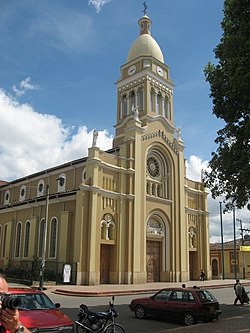Cajicá
| Cajicá | |||
|---|---|---|---|

Church of Cajicá
|
|||
|
|||
| Nickname(s): Fortaleza de Piedra ("The Stone Fortress") |
|||
 Location of the town and municipality of Cajicá in the department of Cundinamarca |
|||
| Coordinates: 4°55′N 74°02′W / 4.917°N 74.033°WCoordinates: 4°55′N 74°02′W / 4.917°N 74.033°W | |||
| Country | Colombia | ||
| Department | Cundinamarca | ||
| Province | Central Savanna Province | ||
| Founded | 5 March 1598 | ||
| Government | |||
| • Mayor | Orlando Díaz Canasto (2016-2019) |
||
| Area | |||
| • City | 50.4 km2 (19.5 sq mi) | ||
| • Urban | 2.73 km2 (1.05 sq mi) | ||
| • Metro | 49.0 km2 (18.9 sq mi) | ||
| Elevation | 2,558 m (8,392 ft) | ||
| Population (2015) | |||
| • City | 56,875 | ||
| • Density | 1,100/km2 (2,900/sq mi) | ||
| • Urban | 35,700 | ||
| Time zone | Colombia standard time (UTC-5) | ||
| Website | Official website | ||
Cajicá is a municipality and town of Colombia in the department of Cundinamarca, 39 km (24 mi) north of the capital Bogotá. It is located in the Central Savanna Province, being the third most populous municipality in the province after Zipaquirá and Chía. It is bordered by the municipalities of Zipaquirá to the north, Sopó to the east, Chía to the south, and Tabio to the west. The town is located at an altitide of 2,558 metres (8,392 ft) and has an average temperature of 14 °C (57 °F).
The name of Cajicá derives from a corruption of the two words ca ("enclosure") and jica ("stone"). Primary sources have two meanings for Cajicá; either derived from the cacique Cajic, or the "stone enclosure" or "stone fortress".
According to imagined history as described by Ángel Luís Román, the area of Cajicá, in the valley of Kaj was inhabited since approximately 12,460 BC.
The stone wall has been described to have been constructed in two phases; an early phase made of wooden poles and a second phase, built between around 1220 and 1400, out of stone, rare for the Muisca. The wall has been described to have been four meters high and 80 centimeters thick. The Muisca fortress was said to be located strategically on the Bogotá savanna between Funza and Fusagasugá in the south and the road to the regions in the north (Boyacá and Santander) roughly on the site known today as Las Manas. Rituals were allegedly performed by the merchants and soldiers travelling through the valley on the road between Zipaquirá and Tabio. It however remains unclear if this stone fortress was built in pre-Columbian time or after the Spanish conquest.
Supposedly at this site the vanguard of the conquistador army of Gonzalo Jiménez de Quesada first encountered the Muisca on March 23, 1537.
...
Wikipedia


